Waves & Tides
Waves
- Waves form our coastlines through erosion, deposition and transportation
- Wind causes waves to move over the surface of the sea:
- Wind creates friction, causing the water to ripple
- These ripples grow into waves
- Waves can have different energy levels depending on:
- Wind strength
- The length of time the wind blows
- The fetch (the distance the wave has travelled)
- If the fetch is larger, the wave will be more powerful
- If the wind is powerful and blows over a longer period, the wave will be larger
- The swash is when a wave moves up the beach
- The backwash is when the wave pulls back out to the ocean
- Waves slow down as they reach a coastline and the water becomes shallower:
- The bottom of the wave experiences friction with the seabed below
- The top part of the wave (crest) gains momentum, pushing over the bottom of the wave
- This is when the wave will break
Diagram of a wave

Diagram of a wave
- There are two types of waves:
- Constructive waves – constructive waves construct or build up beaches through deposition processes
- Destructive waves – destructive waves destroy the coastline through erosion processes
Table comparing constructive and destructive waves
| Constructive Wave | Destructive Wave | |
| Swash | Strong | Weak |
| Backwash | Weak | Strong |
| Wavelength | Long with low height | Short with high height |
| Frequency | Low (6-8 per minute) | High (10-12 per minute) |
| Type of beach | Sandy - depositional | Shingle - erosional |
| Fetch | Small fetch | large fetch |

- Waves can reflect, refract, diffract and interfere:
- Waves can change direction when they slow down through refraction, often seen at headlands and bays
Diagram showing wave refraction

Wave refraction
-
- Waves can reflect, typically seen if a wave collides with a cliff
- Two waves from different directions may meet, causing wave interference
- Waves can also bend, or diffract, when they meet an obstacle or a gap
Tides
- Tides are when the surface of the sea moves up and down
- Gravitational pull (from the moon) controls tidal movements
- The rotation of the earth causes different tidal patterns across the globe
- When the water reaches its highest level, this is high tide:
- As different areas of the earth face the moon, gravity will pull the ocean in the moon’s direction
- Directly on the other side of the earth, high tide will also occur
- High tide causes ocean waters to bulge outwards
- High tide causes the water to spread up the coastline
- As the water sinks back to its lowest level, this is low tide:
- Low tides are located between the two high tides
- The difference between high and low tide is the tidal range
- Spring tides occur if the moon, earth and sun all line up, causing tides to be higher
- Neap tides occur when the moon, earth and sun are at right angles to each other, causing tides to be lower
Tidal differences as the earth rotates

Tidal differences as the earth rotates




